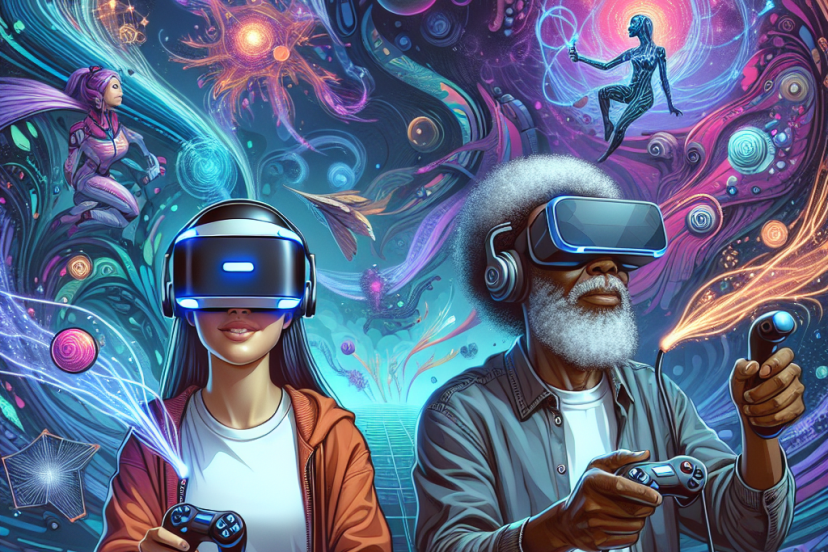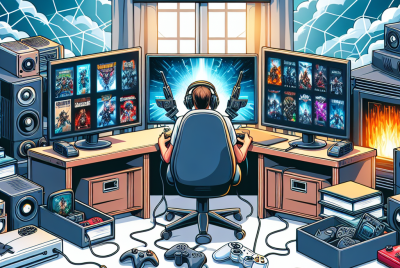Retro Game Treasures That Never Get Old
Retro Game Treasures That Never Get Old
1. Super Mario Bros. (1985)
Shigeru Miyamoto’s masterpiece, Super Mario Bros., is not just a game; it’s a cultural phenomenon that redefined the platform genre. Released for the Nintendo Entertainment System (NES), this game introduced players to the enchanting Mushroom Kingdom, where they took on the role of Mario in his quest to save Princess Peach from the evil Bowser. The game’s tight controls, iconic power-ups like the Super Mushroom and Fire Flower, and unforgettable level designs have cemented its status in gaming history. Its mix of puzzle-solving and action keeps it engaging, and its co-op multiplayer mode can rekindle the camaraderie of the ’80s.
2. The Legend of Zelda (1986)
Another gem from Nintendo, The Legend of Zelda introduced players to the expansive world of Hyrule, filled with secrets and adventures. The innovative top-down perspective and nonlinear gameplay allowed players to explore iconic dungeons at their own pace. Zelda’s rich lore, memorable characters, and challenging puzzles made it revolutionary. The ability to save progress was groundbreaking at a time when many games reset upon being turned off. Its exploration and discovery mechanics set a blueprint for the vast open-world games we enjoy today.
3. Sonic the Hedgehog (1991)
The Sega mascot, Sonic the Hedgehog, burst onto the scene in the early ’90s, introducing a fast-paced twist on platforming. With its stunning colorful graphics and addictive gameplay, Sonic’s goal to defeat Dr. Robotnik (Eggman) captures the essence of ’90s cool. The game’s speed mechanics and innovative level design, including loop-de-loops and hidden areas, encouraged players to return for more, making it a staple of retro gaming. The distinct soundtrack, featuring catchy tunes that accompany Sonic’s run, has helped the game maintain its charm over decades.
4. Tetris (1984)
A simple yet addictive puzzle game, Tetris has transcended generations with its minimalist design and compelling gameplay. Designed by Russian engineer Alexey Pajitnov, the game challenges players to rotate and position falling blocks (tetrominoes) to create complete lines without gaps. Its straightforward premise and competitive nature paved the way for gaming tournaments and leaderboard culture. The iconic music from the Game Boy version has become one of the most recognizable video game soundtracks.
5. Street Fighter II (1991)
Street Fighter II revolutionized the fighting game genre, bringing competitive play to arcades worldwide. With an array of colorful characters, each with unique abilities and special moves, players engage in intense one-on-one battles. The introduction of combos and special attacks set a standard for future fighting games. Street Fighter II’s impact led to a plethora of spin-offs and adaptations across various media, solidifying its legacy in pop culture.
6. Final Fantasy VII (1997)
Final Fantasy VII redefined role-playing games (RPGs) with its captivating narrative, memorable characters, and stunning visuals for its time. Set in a dystopian world, players follow Cloud Strife as he seeks to defeat the malevolent Shinra Corporation and the enigmatic Sephiroth. Beyond its epic storyline, the game introduced real-time combat systems, complex character development, and a richly detailed world, setting the stage for modern RPGs. The iconic materia system allowed for diverse gameplay strategies, encouraging exploration and character customization, a trend still prevalent in today’s RPGs.
7. Donkey Kong (1981)
Donkey Kong introduced the world to Mario in his original form, where he must save a damsel in distress (originally named Pauline) from the titular gorilla. The game is a classic arcade platformer that combines skill and timing. Its level-based progression introduced iconic gameplay mechanics and laid the groundwork for future platforming titles. Each screen brings a unique challenge, leading to intense competition in local arcades. Its simple yet addictive gameplay loop means it still draws players today, either on original hardware or through modern consoles.
8. Pac-Man (1980)
Pac-Man is perhaps the most recognized arcade game, featuring a simple premise where players navigate a maze, eating dots while avoiding ghosts. The game’s appeal lies in its bright colors and strategic gameplay. Pac-Man spawned an entire genre of maze games and cemented its legacy in pop culture, inspiring merchandise, cartoons, and even music hits. Its unique blend of action and strategy allows it to maintain a loyal fanbase, ensuring it’s always a popular pick at retro gaming events.
9. Castlevania: Symphony of the Night (1997)
This landmark game played a vital role in the “Metroidvania” genre, combining platforming and RPG mechanics. Set in Dracula’s castle, players control Alucard on a quest to defeat the iconic vampire. The game’s exploration, coupled with RPG elements such as leveling up, acquiring new abilities, and discovering secrets, offers an engaging gameplay experience that keeps it fresh. Its atmospheric soundtrack and detailed pixel art continue to draw in both nostalgic fans and new players.
10. Mega Man 2 (1988)
Mega Man 2 is often hailed as one of the best action-platformers, introducing the Blue Bomber’s signature style of gameplay. Players traverse through intricate levels, battling unique Robot Masters, each with distinct abilities. The game’s innovative weapon-stealing mechanic, where Mega Man can adopt powers from defeated enemies, adds depth to the gameplay. With its catchy soundtrack and challenging levels, Mega Man 2 keeps players engaged, making it a favorite for speedrunners as well.
11. Contra (1987)
Contra is renowned for its run-and-gun gameplay, fostering a spirit of cooperation in local co-op multiplayer mode. Players navigate through enemy-infested areas, using an array of weapons to take down foes and powerful bosses. The iconic Konami Code provides players with extra lives, adding a layer of excitement. Contra’s straightforward mechanics and pixelated graphics maintain its allure, providing a nostalgic experience for gamers seeking a challenge.
12. The Secret of Mana (1993)
Combining real-time combat with RPG elements, The Secret of Mana revitalized the action RPG genre on the Super Nintendo. Players embark on a captivating quest to restore the balance in the world and save the Mana Tree. Its cooperative multiplayer mode allows friends to join in, making it a unique shared adventure experience. Stunning pixel art and a memorable soundtrack enhance game immersion, ensuring its place in retro gaming hearts.
13. EarthBound (1994)
This quirky RPG stood out with its modern-day setting and humorous storytelling, diverging from the fantasy tropes common in the genre. EarthBound follows Ness and his friends in their quest to save the world from an alien villain named Giygas. Its unusual gameplay mechanics, cheeky dialogue, and unique art style create a memorable experience. The game’s cult following has kept it alive, prompting remakes and continued references in modern media.
14. Chrono Trigger (1995)
Chrono Trigger is often regarded as one of the best video games of all time. Created by a dream team of developers, it features time travel as its core mechanic, allowing players to influence the game’s outcome across multiple timelines. Its engrossing story, developed characters, and innovative combat system—where players can combine abilities for powerful techniques—set it apart. The myriad endings and unreachable secrets ensure that players return for additional adventures in this timeless classic.
15. Duck Hunt (1984)
Utilizing the NES Zapper peripheral, Duck Hunt brought a unique twist to home gaming, merging video games with light gun arcade experiences. Players engage in a hunting simulation, aiming to shoot down as many ducks as possible. The game introduced a competitive element where players could challenge friends to high scores. Its iconic dog that mocks players for missed shots became a defining symbol of classic Nintendo gaming.
16. Space Invaders (1978)
One of the first shooting games that popularized the arcade gaming scene, Space Invaders tasked players with defending Earth from waves of descending extraterrestrials. The game introduced the concept of score-multipliers, encouraging players to rack up points over multiple rounds. Its gameplay mechanic, requiring quick reactions and strategic positioning, influenced countless titles that followed, making it a beloved staple in retro gaming history.
17. Galaga (1981)
As a sequel to Galaxian, Galaga took the space shooter formula and enhanced it with complex enemy patterns and power-ups that allowed players to double their firepower. Its charming yet challenging gameplay proved irresistible, encouraging players to achieve high scores while battling waves of alien adversaries. Galaga is a timeless classic that still engages players through re-releases and compilations, maintaining its standing as an arcade staple.
18. Pong (1972)
Pong laid the groundwork for competitive video gaming, offering a simple yet engaging two-player experience. This table tennis simulation captured the imagination of many, promoting local multiplayer gameplay that is still prevalent in modern gaming. Its straightforward mechanics and fair competition fostered social interactions, making it a cornerstone in the history of video games and a nostalgic reminder of gaming’s roots.
19. Mappy (1983)
As a unique blend of platforming and puzzle-solving, Mappy challenged players to navigate through a house while avoiding cats. The title’s distinct approach to level design, combined with a light-hearted premise and catchy soundtrack, made it an endearing classic. Its mechanics emphasize strategic movement and timing, qualities that continue to resonate with retro game enthusiasts today.
20. Myst (1993)
Myst revolutionized adventure games with its striking graphics and immersive storytelling. Players explore the mysterious island of Myst, solving intricate puzzles while uncovering a deep narrative. Unlike traditional adventure games of the era, Myst featured 3D environments with pre-rendered graphics, pioneering the use of multimedia in gaming. Its unique approach and atmospheric experience laid the groundwork for narrative-driven games in the future.
21. Bubble Bobble (1986)
This charming platformer allows players to control little dinosaurs who trap enemies in bubbles and pop them for points. The cooperative gameplay encourages teamwork as players navigate colorful levels filled with secrets. Its cute graphics combined with high replayability make it a staple of classic arcades, and the catchiness of its soundtrack adds to its enduring appeal.
22. Star Fox (1993)
Star Fox transformed space shooters with its innovative use of 3D graphics and polygonal characters. Players pilot the Arwing spacecraft through various missions, battling enemy ships while navigating asteroids and engaging in boss fights. The game’s cooperative mechanics and various paths create a unique replayable experience while establishing a recognizable franchise that continues to thrive in the gaming industry.
23. Pitfall! (1982)
This iconic platformer pushed the boundaries of the Atari 2600 with its adventurous jungle setting. Players guide Harry as he navigates pitfalls, quicksand, and crocodiles. The game’s time-based scoring system fosters a competitive play style, encouraging players to beat their best times. Pitfall! played a significant role in paving the way for exploration-based platform games, ensuring its legacy in gaming history.
24. Ninja Gaiden (1988)
Known for its challenging difficulty and cinematic storytelling, Ninja Gaiden took players through an action-packed quest of revenge and redemption. Its combination of fast-paced gameplay and engaging narrative interludes set it apart from other action games. The iconic character Ryu Hayabusa became a staple in gaming culture, exhibiting the blend of combat prowess and intricate platforming that characterized many subsequent titles in the genre.
25. Bomberman (1983)
Bomberman is lauded for its addictive multiplayer gameplay involving strategically placing bombs to eliminate enemies and destroy obstacles. Its engaging level design encourages cooperation and competition, with various power-ups enhancing gameplay. Renowned for its local multiplayer modes, Bomberman has continued to evolve while retaining the core mechanics that make it a beloved classic.
Exploring these retro game treasures reveals the timeless qualities that define great gaming. They offer unique experiences that continue to captivate players, bridging generations of gamers. Whether it’s the engaging narratives, memorable characters, or innovative mechanics, these classics maintain their charm and relevance in today’s gaming landscape.




